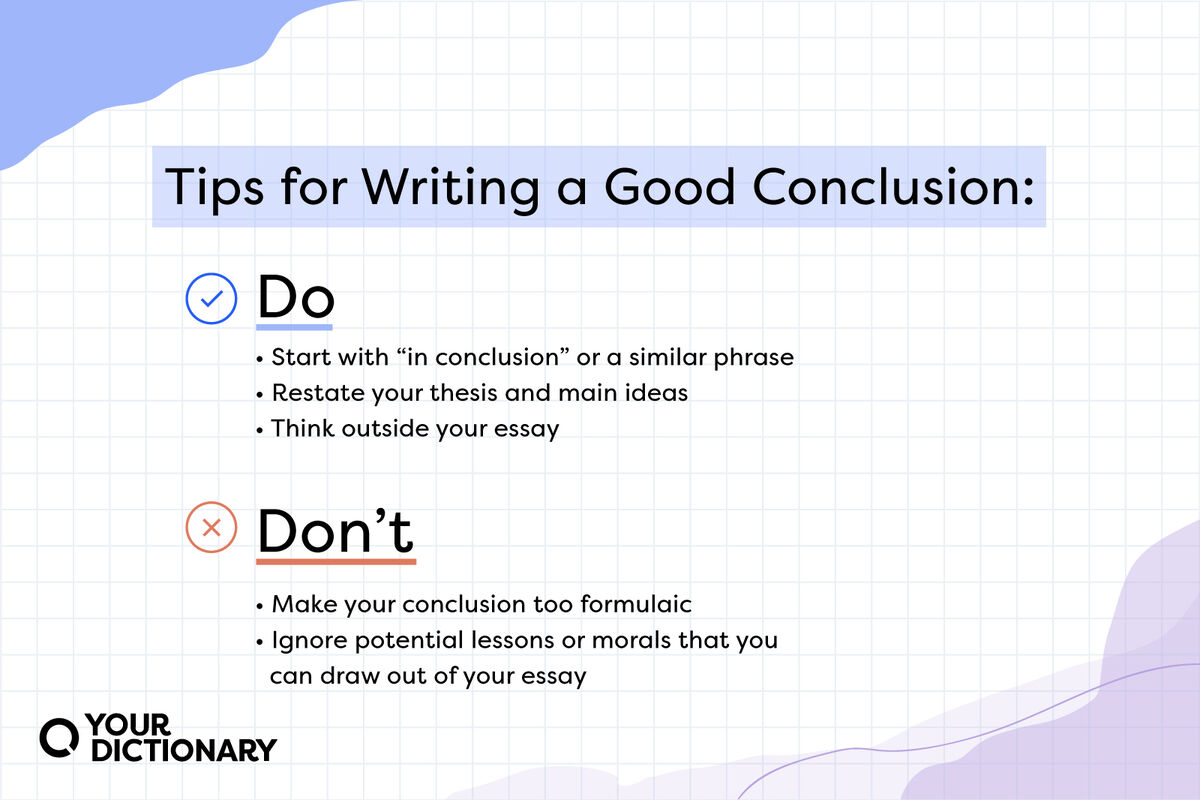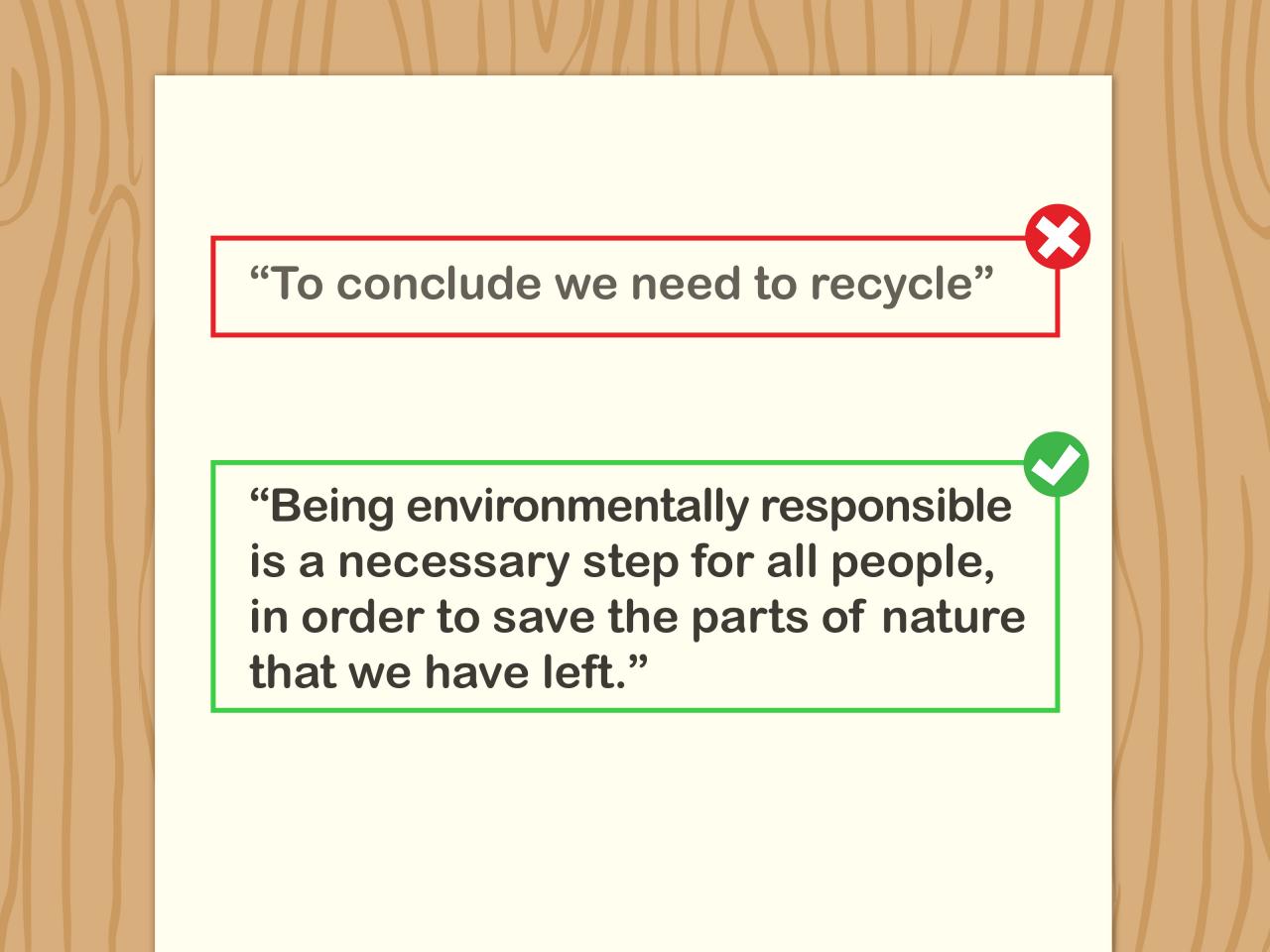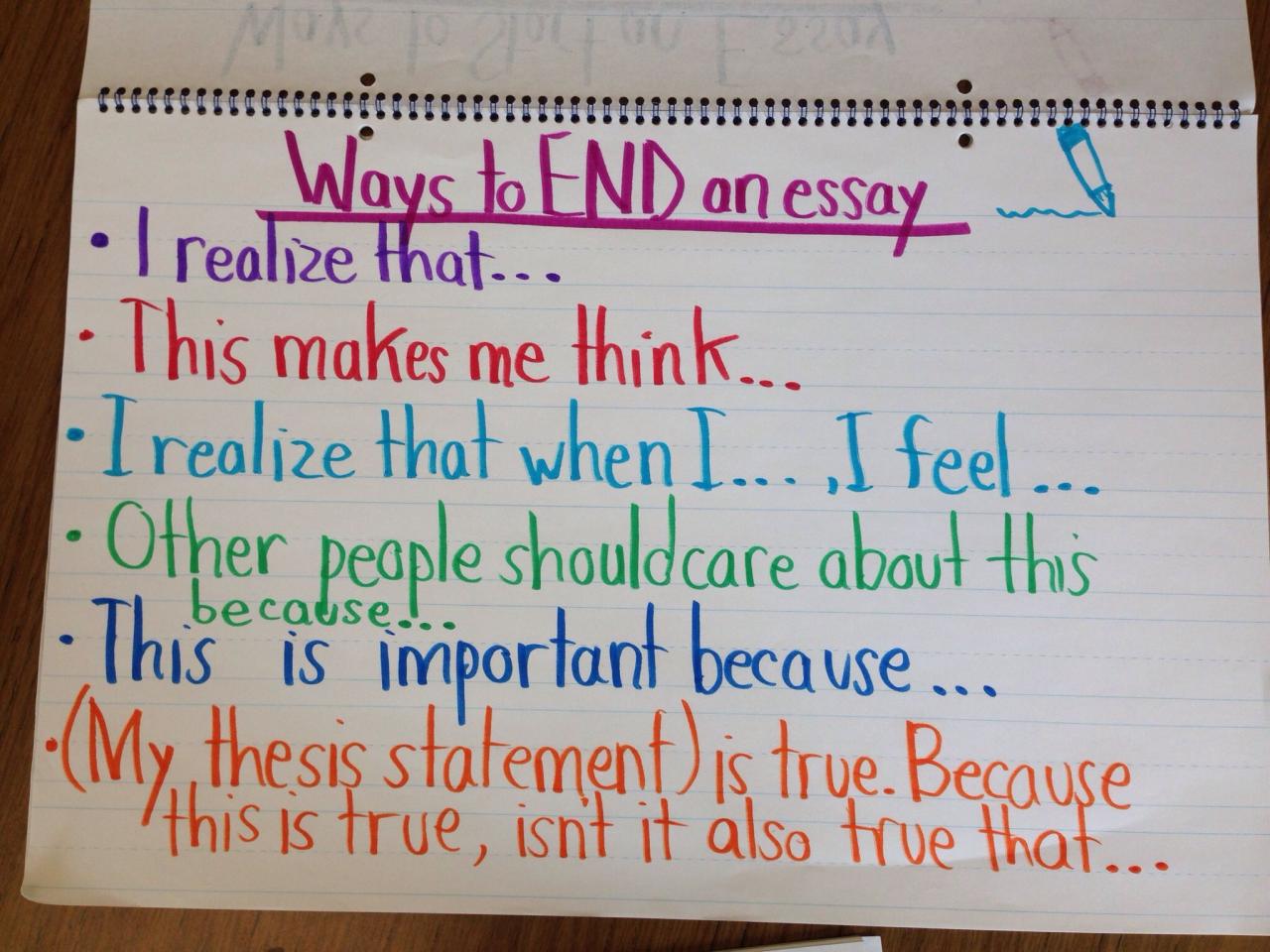A good ending to an essay – In the realm of essay writing, the conclusion holds immense significance, serving as the grand finale that leaves a lasting impression on the reader. It’s your chance to wrap up your arguments, reinforce your thesis, and inspire your audience to take action.
In this guide, we’ll delve into the art of crafting a good ending to an essay, ensuring that your writing resonates long after the final word.
A well-structured conclusion begins with a concise restatement of your thesis statement. This serves as a reminder of the central argument you’ve presented throughout the essay. However, avoid simply repeating your thesis verbatim; instead, rephrase it in a way that emphasizes its significance and reinforces your main points.
Thesis Statement
The main argument of this essay is that the American dream is still alive and well, despite the challenges that many people face. The thesis statement is clear, specific, and arguable. It is clear because it states the main point of the essay in a concise way.
It is specific because it identifies the American dream as the topic of the essay. It is arguable because there are many people who believe that the American dream is dead.
The essay will support the thesis statement by providing evidence that the American dream is still alive and well. This evidence will include stories of people who have achieved the American dream, as well as statistics that show that the American dream is still possible for many people.
One of the main reasons why the American dream is still alive and well is because of the opportunities that are available in the United States. The United States is a land of opportunity, and there are many ways for people to achieve their dreams.
For example, people can start their own businesses, get a good education, or work hard to get a good job. There are many resources available to help people achieve their dreams, such as government programs, non-profit organizations, and educational institutions.
Supporting Evidence

Substantiating claims with solid evidence is crucial for an essay’s credibility and impact. By weaving specific, relevant evidence into the fabric of your writing, you bolster your arguments, enhance your persuasiveness, and establish yourself as a well-informed writer.
To gather credible sources, delve into scholarly databases, reputable news outlets, and peer-reviewed journals. Ensure that the sources you choose are relevant to your topic and align with your thesis statement. When incorporating evidence, avoid mere paraphrasing; instead, engage in critical analysis, interpreting and synthesizing the information to support your claims.
Credible Sources
- Academic Journals:Peer-reviewed publications showcasing cutting-edge research and scholarly insights.
- Government Reports:Official documents providing valuable data, statistics, and policy analyses.
- News Articles:Reputable news organizations offer up-to-date information and expert perspectives.
- Books by Renowned Authors:Works by established experts in their fields carry significant weight and credibility.
Analysis

The need for thorough analysis of evidence is critical in supporting the thesis statement. It involves carefully examining the evidence to identify its strengths, weaknesses, and relevance to the thesis. By doing so, we can determine the validity and reliability of the evidence, ensuring that it effectively supports our argument.
There are various ways to analyze evidence effectively. One method is to consider the credibility of the source. Is it a reputable organization or individual? Does the source have any biases or vested interests that could influence the information presented?
Evaluating Evidence, A good ending to an essay
- Examine the source’s reputation, credibility, and potential biases.
- Consider the context and purpose of the evidence. Is it relevant to the thesis statement?
- Identify any assumptions or limitations within the evidence.
- Compare and contrast different sources to gain a comprehensive understanding.
Identifying Patterns and Relationships
Another approach is to identify patterns and relationships within the evidence. Are there any common themes or trends that emerge? Do the pieces of evidence complement or contradict each other? By recognizing these connections, we can strengthen our understanding of the evidence and its implications for our thesis.
- Look for recurring themes or ideas across multiple sources.
- Examine how different pieces of evidence interact and support each other.
- Identify any gaps or inconsistencies in the evidence.
Drawing Inferences and Conclusions
Finally, we can draw inferences and conclusions from the evidence. This involves interpreting the evidence and making logical connections to support our thesis. However, it’s important to avoid overgeneralizing or making assumptions that are not supported by the evidence.
- Make logical connections between the evidence and the thesis statement.
- Avoid making hasty generalizations or unsupported assumptions.
- Consider alternative interpretations and perspectives.
Organization
A well-organized essay is like a road trip: it should have a clear starting point, logical stops along the way, and a satisfying destination. Organizing your essay in a logical and coherent manner is essential for making your argument clear and easy to follow.One
way to organize your essay is to use a simple three-part structure: introduction, body, and conclusion. The introduction should introduce your topic and thesis statement, the body should develop your argument with evidence and analysis, and the conclusion should restate your thesis and summarize your main points.Within
each section, you should use topic sentences to introduce each paragraph and transition words to connect your ideas. This will help your reader follow your train of thought and understand how your argument is unfolding.Here are some tips for creating a clear and concise essay:*
- *Use headings and subheadings to break up your text. This will make your essay easier to read and navigate.
- *Use bulleted lists and numbered lists to present information in a clear and concise way.
- *Use short paragraphs. A good rule of thumb is to keep your paragraphs to around five sentences or less.
- *Proofread your essay carefully before you submit it. Make sure there are no errors in grammar, spelling, or punctuation.
By following these tips, you can write an essay that is organized, clear, and concise. This will help your reader understand your argument and appreciate your writing skills.
The Importance of a Strong Thesis Statement
A strong thesis statement is the foundation of a good essay. It is a one-sentence statement that expresses the main argument of your essay. A good thesis statement is specific, arguable, and supported by evidence.Your thesis statement should be specific enough to give your reader a clear idea of what your essay is about.
It should also be arguable, meaning that it should be a point that someone could disagree with. Finally, your thesis statement should be supported by evidence from your research.Once you have a strong thesis statement, you can begin to develop your argument.
The body of your essay should provide evidence and analysis to support your thesis statement. The conclusion of your essay should restate your thesis statement and summarize your main points.By following these tips, you can write an essay that is well-organized, clear, and concise.
This will help your reader understand your argument and appreciate your writing skills.
Transitions
Transitions are like the glue that holds an essay together. They help to smoothly connect ideas and paragraphs, making it easy for the reader to follow the flow of your argument. Without transitions, your essay would be a disjointed mess, and it would be difficult for the reader to understand what you’re trying to say.
There are many different types of transitions, but some of the most common include:
- Addition: also, in addition, furthermore, moreover
- Contrast: but, however, on the other hand, in contrast
- Comparison: similarly, likewise, in the same way, in contrast
- Exemplification: for example, for instance, such as
- Explanation: because, since, therefore, as a result
- Sequence: first, second, third, next, finally
Transitions can be used to connect individual sentences, paragraphs, or even entire sections of an essay. When used effectively, they can help to make your writing more cohesive and easier to read.
Example
The following paragraph uses transitions to connect the ideas of the topic sentence to the supporting evidence:
The use of social media has been linked to a number of negative outcomes, such asincreased anxiety and depression. In addition, social media can also lead to cyberbullying and other forms of online harassment. Furthermore, social media can be addictive, and it can be difficult for people to control the amount of time they spend on these platforms.
As a result, it is important to be aware of the potential risks of social media use and to take steps to mitigate these risks.
Call to Action
The conclusion is your final chance to leave a lasting impression on the reader. It’s where you wrap up your argument and provide a call to action.
A call to action is a statement that tells the reader what you want them to do next. It could be anything from signing up for your newsletter to donating to your cause. The best call-to-action statements are clear, concise, and persuasive.
Examples of Effective Call-to-Action Statements
- “Sign up for my newsletter to get the latest updates on my work.”
- “Donate to my cause to help me make a difference in the world.”
- “Visit my website to learn more about my work.”
- “Follow me on social media to stay connected with me.”
- “Share this article with your friends and family to help me spread the word about my cause.”
Avoidance of Clichés and Redundancy: A Good Ending To An Essay

Clichés and redundant language can make writing dull and unoriginal. They are overused phrases that have lost their impact and meaning. For example, instead of saying “He was as happy as a clam,” you could say “His face beamed with joy.”
Common Clichés to Avoid
- As a matter of fact
- All things considered
- At the end of the day
- It goes without saying
- Last but not least
Proofreading and Editing
Proofreading and editing are crucial steps in the essay writing process. They help catch and correct errors in grammar, spelling, and punctuation, ensuring that your essay is polished and professional.
Tips for Proofreading and Editing
- Take a break from writing before proofreading. This allows you to return to your essay with fresh eyes and spot errors more easily.
- Read your essay aloud. This helps you catch errors that you might miss when reading silently.
- Check for grammar, spelling, and punctuation errors. Use a grammar checker or dictionary to help you.
- Have someone else read your essay. A fresh pair of eyes can often spot errors that you missed.
Formatting
Following proper formatting guidelines is essential for producing a well-organized and visually appealing essay. Standard formatting conventions ensure that your essay is easy to read, understand, and navigate.
Standard Formatting Conventions
- Use standard fonts:Times New Roman, Arial, Calibri, or Georgia are widely accepted fonts for academic writing.
- Maintain consistent font size:Typically 12pt for the body text, with larger font sizes for headings and subheadings.
- Set appropriate margins:1 inch on all sides is the standard margin setting.
- Double-space the text:This improves readability and makes it easier to add comments or corrections.
- Indent paragraphs:Use a 5-space indent to visually separate paragraphs.
- Use headings and subheadings:These help organize your essay and make it easier for readers to navigate.
- Include page numbers:This is especially important for longer essays or research papers.
Conclusion Checklist
The conclusion of your essay is your final chance to leave a lasting impression on your reader. It’s where you wrap up your argument, restate your thesis, and provide a call to action. To ensure your conclusion is strong and effective, use the following checklist:
Restate your thesis
Your thesis statement is the central argument of your essay. It should be restated in the conclusion in a clear and concise way. You can do this by using the same wording as your original thesis statement or by paraphrasing it.
Summarize your main points
In the body of your essay, you developed your argument by providing evidence and analysis. In the conclusion, you should summarize your main points and show how they support your thesis. This will help your reader to remember your argument and to see how it all fits together.
Provide a call to action
Your conclusion should end with a call to action. This is where you tell your reader what you want them to do after reading your essay. Your call to action can be anything from asking your reader to donate to a charity to encouraging them to change their behavior.
Proofread and edit
Once you have written your conclusion, be sure to proofread and edit it carefully. Check for errors in grammar, spelling, and punctuation. You should also make sure that your conclusion is clear, concise, and persuasive.
Last Point
Crafting a good ending to an essay is an art form that requires careful attention to detail and a deep understanding of your topic. By following the tips Artikeld in this guide, you can create a conclusion that leaves a lasting impression on your readers, solidifying your essay’s impact and leaving them with a sense of satisfaction and enlightenment.
Clarifying Questions
What is the purpose of a conclusion in an essay?
The conclusion serves as the closing statement of your essay, summarizing your main arguments and leaving a lasting impression on the reader.
How do I restate my thesis statement in the conclusion?
Rephrase your thesis statement in a way that emphasizes its significance and reinforces your main points, avoiding verbatim repetition.
What should I include in a call to action?
A call to action should encourage your readers to take a specific action, such as further research, reflection, or advocacy.